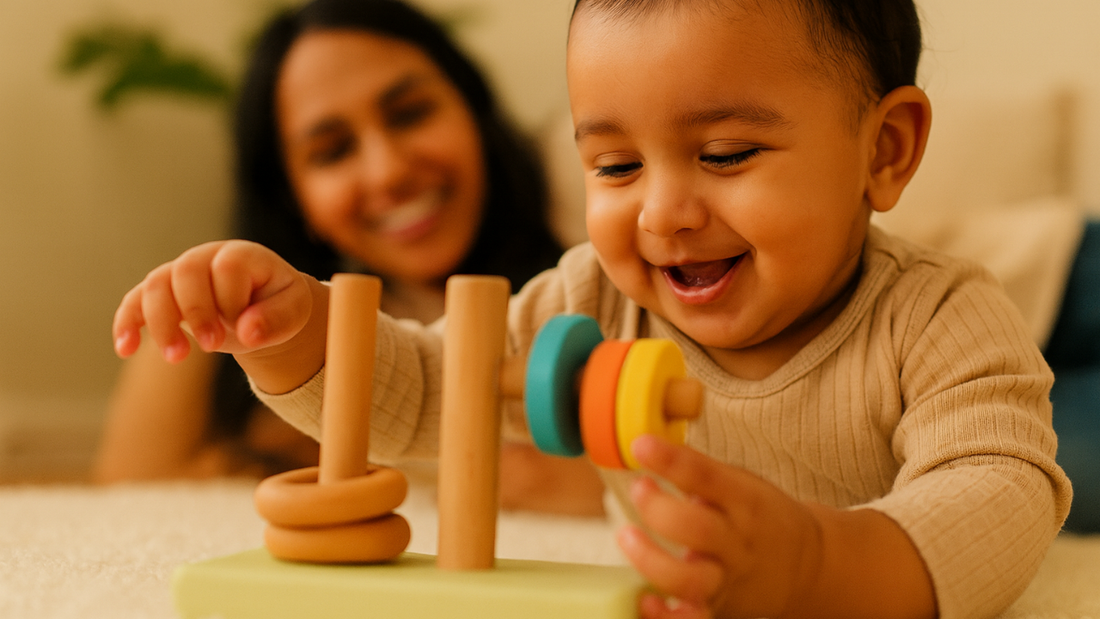
The Hidden Learning Behind Simple Stacking Toys
LiLLBUDAt first, stacking toys might look like just a bunch of colorful blocks or rings. But those happy towers are hiding some of the best early learning your child will ever do. These simple-looking classic toys help babies and toddlers develop the basic motor, cognitive, and problem-solving skills that will help them learn for the rest of their lives.
The Art of Stacking
When your baby stacks, knocks down, and restacks blocks or rings, they are doing more than just playing. Stacking toys get many parts of the brain working at once by combining movement, observation, and reasoning.
Every time you grasp, adjust, or place something, you strengthen the neural connections that help with memory, coordination, and spatial awareness. Stacking is a "multi-skill learning activity" that combines fine motor control, focus, and understanding of cause and effect, according to psychologists and child development experts.
Improving Hand-Eye Coordination and Fine Motor Skills
Stacking toys are some of the best tools for helping kids improve their fine motor skills, which are the small muscle movements that let them hold, pinch, and move things around. Your baby's brain is always sending messages between their eyes and hands as they learn to pick up a ring or balance a block.
This back-and-forth talking helps improve hand-eye coordination, which is important for skills like writing, dressing themselves, and feeding themselves in the future. Every tower they build that wobbles is a little workout for their muscles!
Early problem-solving and thinking about space
When toddlers learn how to put the rings in order or balance blocks so they don't fall, they're doing physics and spatial reasoning without even knowing it. They start to get it:
- Size and arrangement: Learning to tell the difference between big and small, and top and bottom.
- Balance and gravity: Watching what keeps the stack from falling or falling.
- Cause and effect: Knowing that things happen when you do something, like dropping something or losing it.
These are early lessons in STEM learning that teach math and science through play.
Language and Cognitive Development
Stacking toys also help kids learn to talk. Parents can teach their kids new words like "big," "small," "top," "under," "tall," or "fall" during playtime. As your child listens and repeats, they start to connect words with actions and experiences. This is an important step in their early communication development.
Stacking also helps kids learn to stay focused, be patient, and keep going. When a tower falls over, your child learns to try again. This builds emotional strength and determination.
How Parents Can Make Stacking Play More Fun
You don't have any special equipment to make stacking more enjoyable. Here are some simple things you can do to help learning go on longer:
- Play side by side: Demonstrate to your child how to stack objects and have them imitate you.
- Use various objects: Experiment stacking such objects as cups, wooden blocks, or even items you can find around the house, such as boxes or pillows.
- Include telling stories: Turn stacking into a game by saying, "Let's build a castle for your bear!"
- Count and talk about: To help your child learn math and language, say the color and size of each piece out loud or count them.
The goal isn't to build the tallest tower; it's to get kids to be curious and creative while they play.
Outside of the Toy Shelf
Stacking toys may seem simple, but they are a classic example of how kids can learn without fancy gadgets. What seems like quiet play is actually a complicated way of learning that helps with motor coordination, logic, patience, and imagination all at the same time.
So when your child proudly stacks those rings "all by myself," remember that they're not just playing; they're learning how to be smart and independent.

